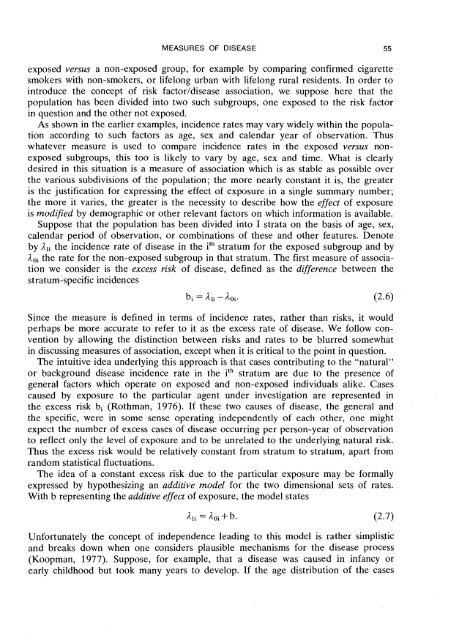3. general considerations for the analysis of case-control ... - IARC
3. general considerations for the analysis of case-control ... - IARC
3. general considerations for the analysis of case-control ... - IARC
Create successful ePaper yourself
Turn your PDF publications into a flip-book with our unique Google optimized e-Paper software.
MEASURES OF DISEASE 55<br />
exposed versus a non-exposed group, <strong>for</strong> example by comparing confirmed cigarette<br />
smokers with non-smokers, or lifelong urban with lifelong rural residents. In order to<br />
introduce <strong>the</strong> concept <strong>of</strong> risk factor/disease association, we suppose here that <strong>the</strong><br />
population has been divided into two such subgroups, one exposed to <strong>the</strong> risk factor<br />
in question and <strong>the</strong> o<strong>the</strong>r not exposed.<br />
As shown in <strong>the</strong> earlier examples, incidence rates may vary widely within <strong>the</strong> population<br />
according to such factors as age, sex and calendar year <strong>of</strong> observation. Thus<br />
whatever measure is used to compare incidence rates in <strong>the</strong> exposed versus nonexposed<br />
subgroups, this too is likely to vary by age, sex and time. What is clearly<br />
desired in this situation is a measure <strong>of</strong> association which is as stable as possible over<br />
<strong>the</strong> various subdivisions <strong>of</strong> <strong>the</strong> population; <strong>the</strong> more nearly constant it is, <strong>the</strong> greater<br />
is <strong>the</strong> justification <strong>for</strong> expressing <strong>the</strong> effect <strong>of</strong> exposure in a single summary number;<br />
<strong>the</strong> more it varies, <strong>the</strong> greater is <strong>the</strong> necessity to describe how <strong>the</strong> effect <strong>of</strong> exposure<br />
is modified by demographic or o<strong>the</strong>r relevant factors on which in<strong>for</strong>mation is available.<br />
Suppose that <strong>the</strong> population has been divided into I strata on <strong>the</strong> basis <strong>of</strong> age, sex,<br />
calendar period <strong>of</strong> observation, or combinations <strong>of</strong> <strong>the</strong>se and o<strong>the</strong>r features. Denote<br />
by ,Ili <strong>the</strong> incidence rate <strong>of</strong> disease in <strong>the</strong> ith stratum <strong>for</strong> <strong>the</strong> exposed subgroup and by<br />
,Ioi <strong>the</strong> rate <strong>for</strong> <strong>the</strong> non-exposed subgroup in that stratum. The first measure <strong>of</strong> association<br />
we consider is <strong>the</strong> excess risk <strong>of</strong> disease, defined as <strong>the</strong> difference between <strong>the</strong><br />
stratum-specific incidences<br />
Since <strong>the</strong> measure is defined in terms <strong>of</strong> incidence rates, ra<strong>the</strong>r than risks, it would<br />
perhaps be more accurate to refer to it as <strong>the</strong> excess rate <strong>of</strong> disease. We follow convention<br />
by allowing <strong>the</strong> distinction between risks and rates to be blurred somewhat<br />
in discussing measures <strong>of</strong> association, except when it is critical to <strong>the</strong> point in question.<br />
The intuitive idea underlying this approach is that <strong>case</strong>s contributing to <strong>the</strong> "natural"<br />
or background disease incidence rate in <strong>the</strong> ith stratum are due to <strong>the</strong> presence <strong>of</strong><br />
<strong>general</strong> factors which operate on exposed and non-exposed individuals alike. Cases<br />
caused by exposure to <strong>the</strong> particular agent under investigation are represented in<br />
<strong>the</strong> excess risk bi (Rothman, 1976). If <strong>the</strong>se two causes <strong>of</strong> disease, <strong>the</strong> <strong>general</strong> and<br />
<strong>the</strong> specific, were in some sense operating independently <strong>of</strong> each o<strong>the</strong>r, one might<br />
expect <strong>the</strong> number <strong>of</strong> excess <strong>case</strong>s <strong>of</strong> disease occurring per person-year <strong>of</strong> observation<br />
to reflect only <strong>the</strong> level <strong>of</strong> exposure and to be unrelated to <strong>the</strong> underlying natural risk.<br />
Thus <strong>the</strong> excess risk would be relatively constant from stratum to stratum, apart from<br />
random statistical fluctuations.<br />
The idea <strong>of</strong> a constant excess risk due to <strong>the</strong> particular exposure may be <strong>for</strong>mally<br />
expressed by hypo<strong>the</strong>sizing an additive model <strong>for</strong> <strong>the</strong> two dimensional sets <strong>of</strong> rates.<br />
With b representing <strong>the</strong> additive effect <strong>of</strong> exposure, <strong>the</strong> model states<br />
Un<strong>for</strong>tunately <strong>the</strong> concept <strong>of</strong> independence leading to this model is ra<strong>the</strong>r simplistic<br />
and breaks down when one considers plausible mechanisms <strong>for</strong> <strong>the</strong> disease process<br />
(Koopman, 1977). Suppose, <strong>for</strong> example, that a disease was caused in infancy or<br />
early childhood but took many years to develop. If <strong>the</strong> age distribution <strong>of</strong> <strong>the</strong> <strong>case</strong>s

















